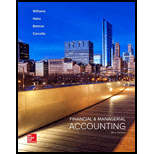
Concept explainers
a)
Prepare a
a)
Explanation of Solution
Bonds: Bonds are long-term promissory notes that are issued by a company while borrowing money from investors to raise fund for financing the operations.
Prepare a journal entry to record the issuance of the bonds on September 1, 2018:
| Date | Account title and Explanation | Post Ref. |
Debit ($) |
Credit ($) |
| September 1, 2018 | Cash | 5,075,000 | ||
| Bonds payable | 5,000.000 | |||
| Bonds interest payable (1) | 75,000 | |||
| (To record the issuance of bonds and 3 months accrued interest) |
Table (1)
- Cash (asset) is increased by $5,075,000. Thus, it is debited.
- Bonds payable (liability) is increased by $5,000.000. Thus, it is credited.
- Bonds interest payable (liability) is increased by 75,000. Thus, it is credited.
Working note:
The bonds were issued on September 1, 2018, at 100 plus three months’ accrued interest (June, July and August). Interest rate is 6%.
Calculate the bonds interest payable (3 months accrued interest):
b)
Prepare a journal entry to record the first semi-annual interest payment on the issued bond on December 1, 2018.
b)
Explanation of Solution
Interest: Interest is an amount paid on the issue price of the bonds by the company at stated dates at stated rate of interest.
Prepare a journal entry to record the first semi-annual interest payment on the issued bond on November 1, 2018:
| Date | Account title and Explanation | Post Ref. |
Debit ($) |
Credit ($) |
| December 1, 2018 | Bonds interest payable(1) | 75,000 | ||
| Bonds interest expense (2) | 75,000 | |||
| Cash | 150,000 | |||
| (To record the first semi-annual interest on bonds) |
Table (1)
- Bonds interest payable (liability) is decreased by 75,000. Thus, it is debited.
- Bond interest expense (decreases the equity) is increased by $75,000. Thus, it is debited.
- Cash (asset) is decreased by $150,000. Thus, it is credited.
Working note:
Calculate the bonds interest expense
From September 1 to December 1 (interest expense) three months interest expense is incurred.
c)
Prepare a journal entry to record interest expense accrued through year-end on December 31, 2018.
c)
Explanation of Solution
Accrued expenses: Accrued expenses are the expenses that have been incurred but have not been paid yet. These accrued expenses create accrued liabilities. For the portion of payment made, accrued liabilities would be reduced by way of passing an
Example: Accrued salaries expense and accrued interest expense.
Prepare a journal entry to record interest expense accrued through year-end on December 31, 2018:
| Date | Account title and Explanation | Post Ref. |
Debit ($) |
Credit ($) |
| December 31, 2018 | Bonds interest expense | 25,000 | ||
| Bonds interest payable (3) | 25,000 | |||
| (To record the issuance of bonds and 1 month accrued interest) |
Table (1)
- Bond interest expense (decreases the equity) is increased by $25,000. Thus, it is debited.
- Bonds interest payable (liability) is increased by 25,000. Thus, it is credited.
Working note:
Calculate the accrued interest (1 month accrued interest):
d)
Prepare a journal entry to record the second semi-annual interest payment on June 1, 2019.
d)
Explanation of Solution
Prepare a journal entry to record the second semi-annual interest payment on the issued bonds on June 1, 2019:
| Date | Account title and Explanation | Post Ref. |
Debit ($) |
Credit ($) |
| June 1, 2019 | Bonds interest payable(3) | 25,000 | ||
| Bonds interest expense (4) | 125,000 | |||
| Cash | 500,000 | |||
| (To record the first semi-annual interest on bonds) |
Table (1)
- Bonds interest payable (liability) is decreased by 25,000. Thus, it is debited.
- Bond interest expense (decreases the equity) is increased by $125,000. Thus, it is debited.
- Cash (asset) is decreased by $150,000. Thus, it is credited.
Working note:
In the second semi-annual interest payment, 1 month interest is recorded as accrued interest for a year end adjustment. This adjustment entry is reversed and interest expense is calculated for remaining 5 months (January 1 to June 1).
Calculate the bonds interest expense:
e)
Find the prevailing market rate of interest on the date that the bonds were issued and explain the same.
e)
Explanation of Solution
6% is the prevailing market rate of interest on the date that the bonds were issued. The reason for it is the bonds were issued at par ($100) and the market rate had to have equalled the contract interest rate printed on the bonds.
Want to see more full solutions like this?
Chapter 10 Solutions
Financial & Managerial Accounting

 AccountingAccountingISBN:9781337272094Author:WARREN, Carl S., Reeve, James M., Duchac, Jonathan E.Publisher:Cengage Learning,
AccountingAccountingISBN:9781337272094Author:WARREN, Carl S., Reeve, James M., Duchac, Jonathan E.Publisher:Cengage Learning, Accounting Information SystemsAccountingISBN:9781337619202Author:Hall, James A.Publisher:Cengage Learning,
Accounting Information SystemsAccountingISBN:9781337619202Author:Hall, James A.Publisher:Cengage Learning, Horngren's Cost Accounting: A Managerial Emphasis...AccountingISBN:9780134475585Author:Srikant M. Datar, Madhav V. RajanPublisher:PEARSON
Horngren's Cost Accounting: A Managerial Emphasis...AccountingISBN:9780134475585Author:Srikant M. Datar, Madhav V. RajanPublisher:PEARSON Intermediate AccountingAccountingISBN:9781259722660Author:J. David Spiceland, Mark W. Nelson, Wayne M ThomasPublisher:McGraw-Hill Education
Intermediate AccountingAccountingISBN:9781259722660Author:J. David Spiceland, Mark W. Nelson, Wayne M ThomasPublisher:McGraw-Hill Education Financial and Managerial AccountingAccountingISBN:9781259726705Author:John J Wild, Ken W. Shaw, Barbara Chiappetta Fundamental Accounting PrinciplesPublisher:McGraw-Hill Education
Financial and Managerial AccountingAccountingISBN:9781259726705Author:John J Wild, Ken W. Shaw, Barbara Chiappetta Fundamental Accounting PrinciplesPublisher:McGraw-Hill Education





